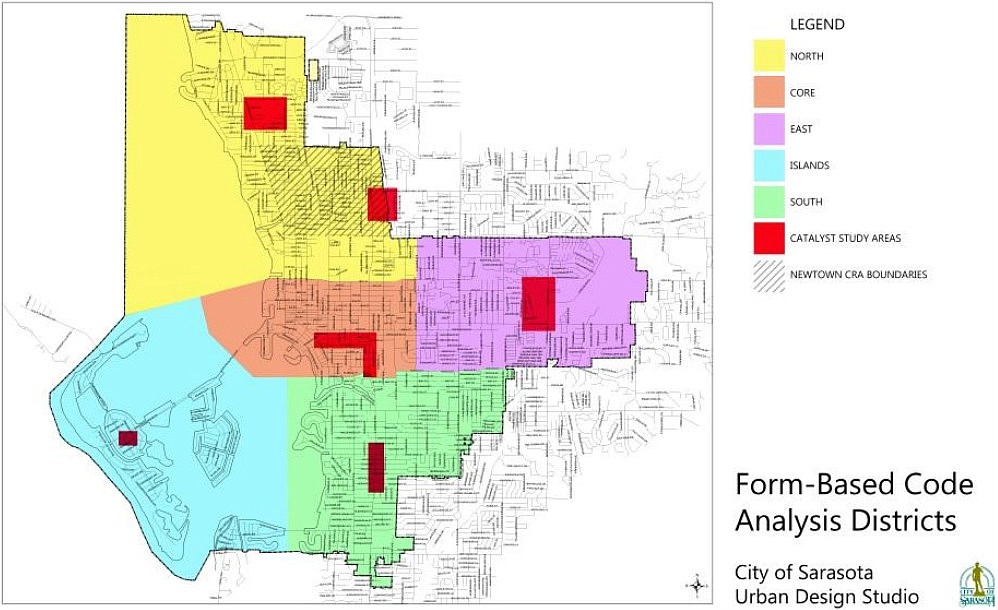- April 24, 2024
-
-
Loading

Loading

The Urban Design Studio was given three years to write a new form-based zoning code for the city, but after five months of work, it’s ready to implement the new code — on a smaller scale.
At a joint workshop of the City Commission and Sarasota Planning Board Friday, Dec. 13, the Urban Design Studio team outlined six catalyst areas where it will begin implementing the form-based code. The catalyst areas are designed to become examples of what a form-based code would look like in different areas of Sarasota.
“The importance of these catalyst areas is not only to test the code on a small scale before proposing it on a large scale, but to get a variety of different problems or challenges we see in the city,” Principal Urban Designer Andrew Georgiadis said.
The Urban Design Studio broke the city into five zones based on geography, selecting at least one catalyst area in each zone. The proposed catalyst areas are centered on:
• South Tamiami Trail, between Hillview Street and Webber Street;
• The southern borders of downtown, adjacent to Laurel Park;
• St. Armands Circle;
• Strip mall at the northwest corner of Fruitville and Beneva roads;
• Marian Anderson Place; and
• North Water Tower Park.
The goals of the catalyst projects vary by location — in St. Armands Circle, for example, the focus is not on buildings, but on signage, parking and native landscaping. In other places, such as the northern, southern and eastern catalyst areas, the emphasis is a more traditional facet of form-based code: creating predictable mixed-use developments and promoting walkable neighborhoods.
“People want walkable communities; they want mixed-use,” Urban Design Studio Director Karin Murphy said. “We just have to get our act together to be able to create those opportunities for the developers to deliver that, as well.”
In the downtown catalyst area, the goal is to create a better transition from the urban core to the residential areas in Laurel Park. Laurel Park residents have fought for greater oversight of large-scale developments at the edge of the neighborhood, and the Urban Design Studio team said it was searching for avenues to satisfy both developers and residents.
“Near Laurel Park, we're looking at scale,” Georgiadis said. “How do we transition down from the taller buildings of the downtown area to the more human scale that's mostly comprised of one- or two-story buildings in Laurel Park?”
Laurel Park Neighborhood Association President Kate Lowman said she was interested in promoting a compatible transition from downtown to the neighborhood, but that she had yet to see any concrete ideas from the Urban Design Studio.
“We haven't really had a lot of conversation about where they're going, because they haven't really told us yet,” Lowman said.
At last week’s workshop, the Urban Design Studio team mentioned offering incentives for developers willing to build on a smaller scale. Lowman said she was encouraged that the Urban Design Studio was looking for solutions that would satisfy all sides, but that she wanted to know how such an incentive-based system would work.
One clear proposal from the Urban Design Studio went over well with Lowman. Georgiadis said the city should prioritize improving the connectivity to Payne Park across U.S. 301, a move Lowman said the city should pursue, if possible.
“I think everyone would agree that having better access to Payne Park, which the city's invested so much money in, would be a good thing,” Lowman said. “Good for the neighborhood, good for the park — it'd be good for everyone.”
To begin implementing changes in the targeted areas, the Urban Design Studio team will recommend text amendments to the current zoning code in March. The final step before fully activating the catalyst zones will be a series of changes to the city’s comprehensive plan in May.
After hearing its first formal update on the Urban Design Studio’s work, city officials appeared encouraged about the transition to a form-based code.
“This is really a handcrafted, localized effort,” City Manager Tom Barwin said. “I have a feeling we're going to see a lot of good things come out of this.”
Contact David Conway at [email protected]